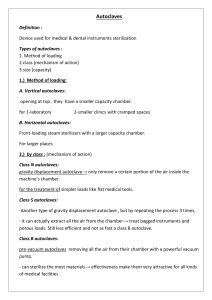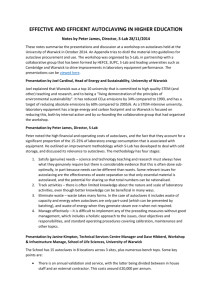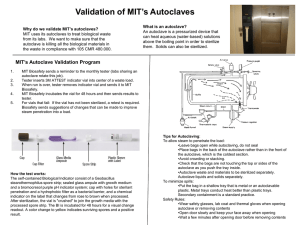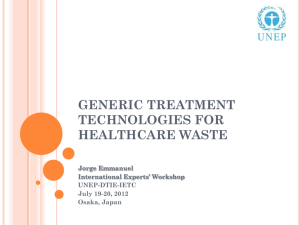Autoclaves-Pressure-vessels-Systems-and
advertisement
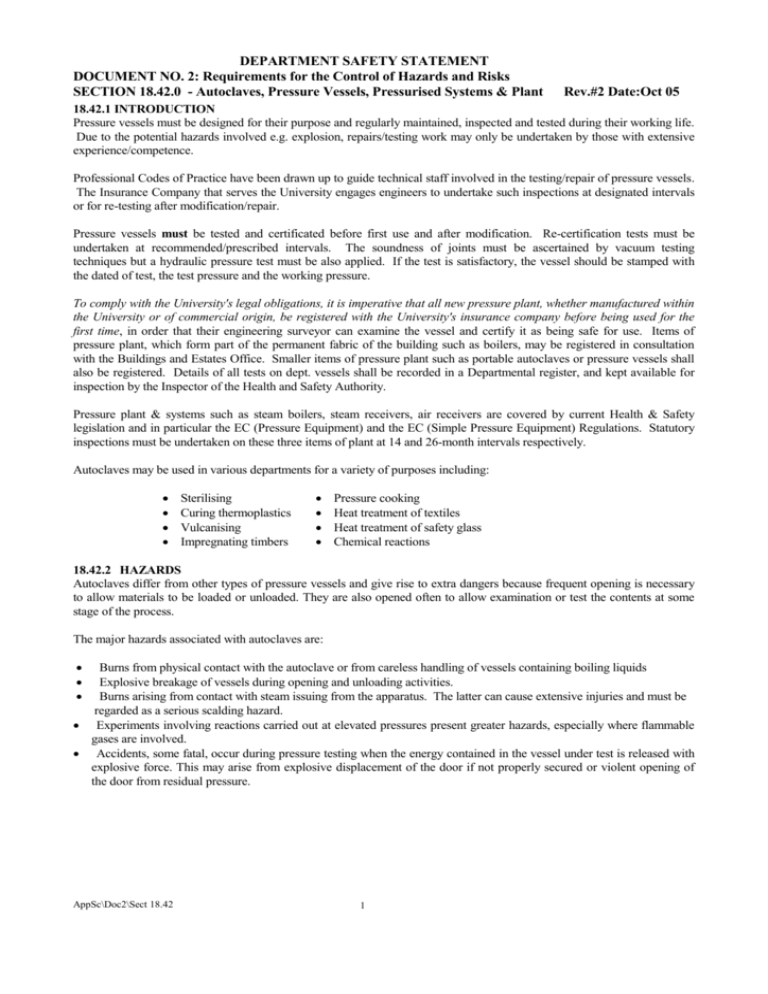
DEPARTMENT SAFETY STATEMENT DOCUMENT NO. 2: Requirements for the Control of Hazards and Risks SECTION 18.42.0 - Autoclaves, Pressure Vessels, Pressurised Systems & Plant Rev.#2 Date:Oct 05 18.42.1 INTRODUCTION Pressure vessels must be designed for their purpose and regularly maintained, inspected and tested during their working life. Due to the potential hazards involved e.g. explosion, repairs/testing work may only be undertaken by those with extensive experience/competence. Professional Codes of Practice have been drawn up to guide technical staff involved in the testing/repair of pressure vessels. The Insurance Company that serves the University engages engineers to undertake such inspections at designated intervals or for re-testing after modification/repair. Pressure vessels must be tested and certificated before first use and after modification. Re-certification tests must be undertaken at recommended/prescribed intervals. The soundness of joints must be ascertained by vacuum testing techniques but a hydraulic pressure test must be also applied. If the test is satisfactory, the vessel should be stamped with the dated of test, the test pressure and the working pressure. To comply with the University's legal obligations, it is imperative that all new pressure plant, whether manufactured within the University or of commercial origin, be registered with the University's insurance company before being used for the first time, in order that their engineering surveyor can examine the vessel and certify it as being safe for use. Items of pressure plant, which form part of the permanent fabric of the building such as boilers, may be registered in consultation with the Buildings and Estates Office. Smaller items of pressure plant such as portable autoclaves or pressure vessels shall also be registered. Details of all tests on dept. vessels shall be recorded in a Departmental register, and kept available for inspection by the Inspector of the Health and Safety Authority. Pressure plant & systems such as steam boilers, steam receivers, air receivers are covered by current Health & Safety legislation and in particular the EC (Pressure Equipment) and the EC (Simple Pressure Equipment) Regulations. Statutory inspections must be undertaken on these three items of plant at 14 and 26-month intervals respectively. Autoclaves may be used in various departments for a variety of purposes including: Sterilising Curing thermoplastics Vulcanising Impregnating timbers Pressure cooking Heat treatment of textiles Heat treatment of safety glass Chemical reactions 18.42.2 HAZARDS Autoclaves differ from other types of pressure vessels and give rise to extra dangers because frequent opening is necessary to allow materials to be loaded or unloaded. They are also opened often to allow examination or test the contents at some stage of the process. The major hazards associated with autoclaves are: Burns from physical contact with the autoclave or from careless handling of vessels containing boiling liquids Explosive breakage of vessels during opening and unloading activities. Burns arising from contact with steam issuing from the apparatus. The latter can cause extensive injuries and must be regarded as a serious scalding hazard. Experiments involving reactions carried out at elevated pressures present greater hazards, especially where flammable gases are involved. Accidents, some fatal, occur during pressure testing when the energy contained in the vessel under test is released with explosive force. This may arise from explosive displacement of the door if not properly secured or violent opening of the door from residual pressure. AppSc\Doc2\Sect 18.42 1 DOCUMENT NO. 2: Requirements for the Control of Hazards and Risks SECTION 18.42.0 - Autoclaves, Pressure Vessels, Pressurised Systems & Plant Rev.#2 Date:Oct 05 18.42.3 RISKS The risks associated with the aforementioned hazards are to be assessed by the Department (using the appropriate technical input where necessary). These assessments shall be carried out using: (i) Check lists provided (where applicable) and (ii) Departmental Hazard Identification/Risk Assessment Work Sheets contained in Document No.3 i.e. Departmental Hazard Risk Assessment (D.H.R.A.). 18.42..4 ARRANGEMENTS AND CONTROLS REQUIRED These hazards and risks will be minimised by the following arrangements and controls: 18.42.4.1 Autoclaves: Only authorised and trained personnel may operate autoclaves Operators of autoclaves shall be fully trained in correct operating procedures and function of controls and safety devices Autoclaves shall meet the latest relevant safety standards e.g. EN BS Autoclaves for sterilising and disinfecting medical products, EN BS Autoclaves for sterilising in laboratories and EN BS Specification for domestic pressure cookers Every autoclave shall be provided with the following fittings: (a) A suitable safety valve with a discharge system that is visible and/or audible and located where it will not cause harm (b) A suitable reducing valve to prevent the safe working pressure from being exceeded (c) A suitable isolating or stop valve on the inlet line in addition to any door interlocked safety valve (d) A well located suitable pressure indicating gauge (e) Suitable drain system where sediment or liquid is likely to accumulate All autoclaves shall be clearly and permanently marked with an identification number and maximum permissible working pressure. In addition, where the process liquid is a fluid at elevated temperature, it shall be marked with the maximum operation temperature, clearly shown on the temperature gauge Only operate the autoclave, whether quick-opening or bolted type doors, in accordance with the maker’s instructions. Doors shall be interlocked with a time delay device to ensure that doors may not be opened until all residual energy has been dissipated. Ensure the water level is above the level of heating elements. During operation, report any malfunction, particularly if the steam safety valve fails to operate normally. If the autoclave has to be left unattended, check periodically to see that all is well. After autoclaving, ensure that the pressure is at zero and that the temperature is below the boiling point of any liquid in the load before opening the autoclave and ensure steam and drainage taps are closed Most accidents occur during the final operations of opening and unloading the autoclave. Even after the pressure gauge has registered zero, leave it for a few minutes to ensure that the pressure inside is truly atmospheric. Wear arm length protective gauntlets, a leather apron and a face visor when unloading. Beware of residual steam in the apparatus and do not lean over top-loading autoclaves to examine the contents, as a flask might burst. When opening front-loading autoclaves, it is wise to stand so that as the door is opened it shields you body from the autoclave. Beware of boiling condensate running out as the door is opened. (To this end sandals are not recommended for operators). When finished, remove any debris from the autoclave. If left, these will block drain valves and could create a hazard for other users. Suitable protective clothing (visor, gloves, shoes and apron) shall be worn whilst opening doors/loads. Suitable shielding should also be provided. Water shall be drained once per week to avoid corrosion. When loading, loosen the caps of screw-topped vessels. Do not overload the machine Where autoclaves are used for sterilising liquids in sealed glass containers a safety system must be in place to prevent the door from being opened until the temperature in all the containers have fallen to below 80o C. This could consist of sensing probes or a time-activated door interlock AppSc\Doc2\Sect 18.42 2 DOCUMENT NO. 2: Requirements for the Control of Hazards and Risks SECTION 18.42.0 - Autoclaves, Pressure Vessels, Pressurised Systems & Plant Rev.#2 Date:Oct 05 18.42.4 ARRANGEMENTS AND CONTROLS REQUIRED (Cont.) 018.42.4.1 Autoclaves (Cont.): Hazardous materials like phenolic disinfectants or cellulose nitrate must not be autoclaved. Autoclaves shall be periodically examined and maintained in accordance with current specifications. Records to be kept of all such checks All pressure vessels shall be isolated in a suitable room/building and be equipped with pressure gauge and a safety valve or bursting disc. Passive ventilation/extraction and air-cooling shall also be provided as necessary. Departments using steam autoclaves and other pressure vessels shall arrange for an annual overhaul and testing of the equipment. The Buildings & Estates Office will make the necessary arrangements, on request, with the University's insurance company. 18.42.4.2 All Pressurised Plant and Systems: All plant and systems must be designed, constructed and installed to prevent danger. Systems must be properly maintained by a strict schedule. Modifications or repairs shall be fully tested and the plant/vessel re-certificated by the Insurance Company Surveyors before the plant/vessel is put back into service. Written procedures drawn up by a competent person, shall be put in place for the examination of certain pressure vessels, such as air receivers, steam boilers, steam receivers, fitting and associated pipework. Records shall be kept of all examinations and certificates issued. Pressure tests should be undertaken on all plant/lines before first use. All joints in high-pressure pipework shall be welded and x-ray tested. Steam boilers and steam receivers shall have safety valves, stop valves and gauges fitted. Steam receivers may also need to be fitted with a reducing valve, if they are not designed and maintained to withstand the maximum working pressure of the boilers. Air received shall show a visible safe working pressure and be fitted with a safety valve, a pressure gauge and a drainage appliance. A competent person shall certificate steam receivers and air receivers every 26 months. Steam boilers shall be certificated every 14 months. Automatically controlled steam and hot water boilers such as the University’s central steam boiler, shall be operated in accordance with the Health and Safety Executive Plant and Machinery Guidance Note PM No.5. “Automatically controlled steam and hot water boilers.” Steam boiler blow down systems shall be in accordance with HSE PM60. 18.42.5 ARRANGEMENTS AND CONTROLS The details of the Arrangements and Controls in place and those required in the short, medium and long term, shall be set out by the Department in the forms provided in Document No.4 i.e. Departmental Safety Action Plan (D.S.A.P.). These Arrangements and Controls shall be reviewed and updated on a yearly basis. 18.42.6 RESPONSIBILITIES The following personnel are responsible in the Department/Lab/Area for ensuring the implementation and ongoing compliance with the aforementioned arrangements and controls. AREA/LOCATION PERSON RESPONSIBLE 1. 2. 3. 4. 5. 6. AppSc\Doc2\Sect 18.42 3
